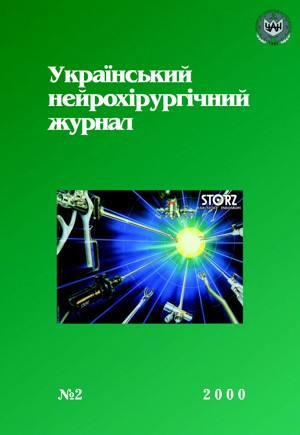The influence of heterotopic transplantation of hippocampal tissue on functional and morphologic integration with recipient
Keywords:
трансплантація, головний мозок, гіпокамп, електроенцефалограма, нейроспецифічні білки, експериментальне дослідженняAbstract
In the article are represented the results of experimental researches directed on learning of influence implantation of hippocampal tissue with various cell components. These experiments were carried on three groups of animals which underwent intraparenchimal transplantation into the senco-motor cortex. The first group received fetal hippocamp tissue, second — postnatal, thirds — glial-riched hippocampal suspension. In various terms following transplantation the electrophysiological studies are conducted. These studies directed on learning to background electrical activity of a brain of recipient. The test of functional load and test for convulsive readiness of a brain were executed. Also were studied role neuromediator systems in phenomena of bioelectrical activity of a brain. The development of autoimmunological responses to neurospecific proteins is shown. Is shown good survival and adaptation of fetal hippocamp and glial-riched hippocampal suspension. The grafted cells can restore their plastic properties and can to be differentiated in the mature forms according to their structural specificity.
References
1. Berezhnoy G. [Device for preparative separation of proteins in polyacrylamide gel]. Ukr biokhim zhurn. 1978;50(1):116-126. Russian.
2. Berezhnoy G. [Isolation and some properties of the D antigen neurospecific]. Ukr biokhim zhurn. 1984;56(2):123-126. Russian.
3. Boldyrev A. [Epilepsy In Adults]. Moscow: Meditsina; 1984:288. Russian.
4. Didimova E, Svanidze I. [Some features of the contractile activity of glial cells in the explants and dissociated cultures]. In: Abstracts Book Of The I All-Union. Symposium "Excitable Cells In Tissue Culture.". Pushchino; 1984:8:18-23. Russian.
5. Laponogov O, Tsymbalyuk V, Antonenko V, Kostyuk K. [Stereotactic method of transplantation of embryonic neural tissue in the treatment of epilepsy in children]. In: Abstracts Book Of The II Congress Of Neurological Surgeons Russ. Federation. Nizhny Novgorod; 1998: 208. Russian.
6. Palladín A, Terlits'ka Y, Kozulína O. [Protein structural formations of brain tissue]. Ukr biokhim zhurn. 1970;42(2):144-154. Ukrainian.
7. Polezhayev L. [Transplantation Of Brain Tissue In Health And Disease]. Moscow: Nauka; 1986:151. Russian.
8. Ed. By Вепринцев B et al. [Guidelines For The Cultivation Of Nerve Tissue: Methods. Equipment. Problems]. Moscow: Nauka; 1988:317. Russian.
9. Tsimbalyuk V, Pіchkur L, Tsіmeyko O. [Transplantation of embryonic brain tissue in patients with organic brain damage]. In: Theses of the I Congress Of Neurosurgeons Ukraine. Kyiv; 1993:210. Ukrainian.
10. Tsymbalyuk V, Laponogov O, Kostyuk K. [Neyrotransplantatsiyi on aspects of epileptic brain activity]. Ukr med chasopys. 1998;4(7-8):5-16. Ukrainian.
11. Cherenʹko. [Sensebilizatsiya To Neurospecific Proteins In Patients With Closed Craniocerebral Injury] [dissertation]. Kiev; 1989:26. Russian.
12. Cherchenko A, Tsimbalyuk V, Nahornyy E, Kostyuk K. Epileptohenni properties glial. In: Theses of the I Congress of Ukrainian antiepileptic League. Odessa; 1996:66. Ukrainian.
13. Burke J, Benson P. Web alert Neuronal and glial cell biology Disease, transplantation and regeneration. Current Opinion in Neurobiology. 1997;7(5):593. [CrossRef]
14. Buzsáki G, Bayardo F, Miles R, Wong R, Gage F. The grafted hippocampus: An epileptic focus. Experimental Neurology. 1989;105(1):10-22. [CrossRef]
15. Cunningham M, McKay R. Transplantation strategies for the analysis of brain development and repair. J Neurol. 1994;242(S1):S40-S42. [CrossRef]
16. Jones D, Redpath C. Regeneration in the central nervous system: Pharmacological intervention, xenotransplantation, and stem cell transplantation. Clinical Anatomy. 1998;11(4):263-270. [CrossRef]
17. Madrazo I, Franco-Bourland R, Ostrosky-Solid F. et al. Neural transplantation (auto—adrenal, fetal nigral and fetal adrenal) in Parkinson’s disease: The Mexican experience. Prog Brain Res. 1990; 82:593-602. [PubMed]
18. Purpura D, Gonzalez-Monteagudo O. Acute effects of methoxypyridoxine on hippocampal end-blade neurons: an experimental study of "special pathoclisis" in the cerebral cortex. Journal of Neuropathology and Experimental Neurology. 1960;19(3):421-432. [CrossRef]
19. Saltykow S. Versuche über Gehirnreplantation, zugleich ein Beitrag zur Kenntniss reactiver Vorgänge an den zelligen Gehirnelementen. Arch F Psychiatr U Z Neur. 1905;40(2):329-388. [CrossRef]
20. Swanson T.H. The pathophysiology of human mesial temporal lobe epilepsy. J Clin Neurophysiol. 1995 Jan;12(1):2-22. [PubMed]
Downloads
How to Cite
Issue
Section
License
Copyright (c) 2000 Kostyantyn Kostiuk

This work is licensed under a Creative Commons Attribution 4.0 International License.
Ukrainian Neurosurgical Journal abides by the CREATIVE COMMONS copyright rights and permissions for open access journals.
Authors, who are published in this Journal, agree to the following conditions:
1. The authors reserve the right to authorship of the work and pass the first publication right of this work to the Journal under the terms of Creative Commons Attribution License, which allows others to freely distribute the published research with the obligatory reference to the authors of the original work and the first publication of the work in this Journal.
2. The authors have the right to conclude separate supplement agreements that relate to non-exclusive work distribution in the form of which it has been published by the Journal (for example, to upload the work to the online storage of the Journal or publish it as part of a monograph), provided that the reference to the first publication of the work in this Journal is included.









